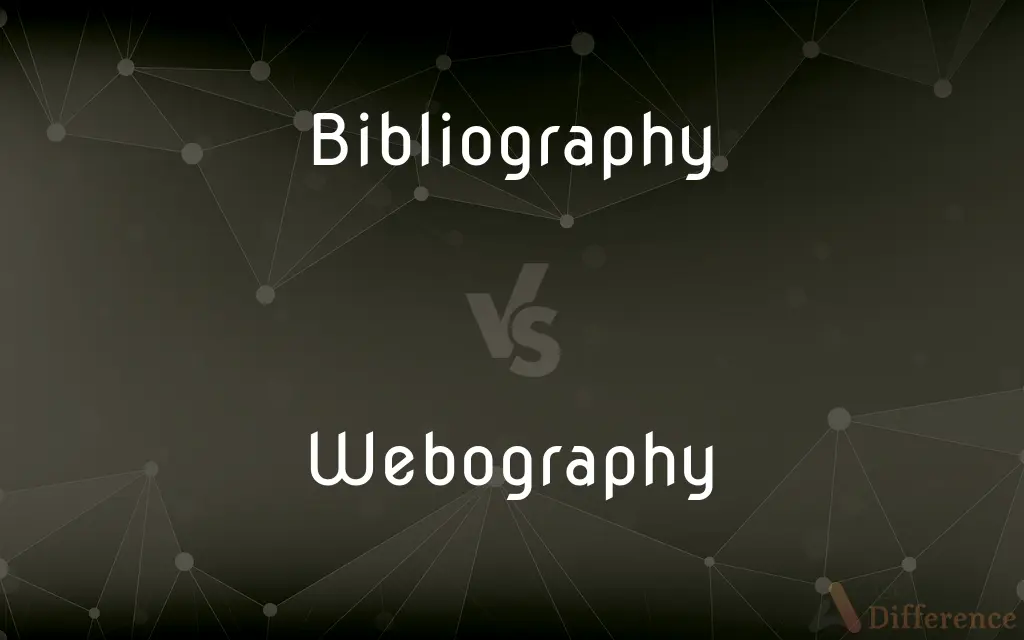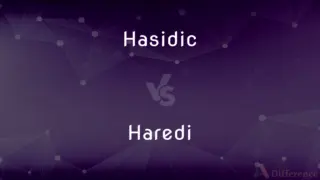Bibliography vs. Webography — What's the Difference?
By Maham Liaqat & Fiza Rafique — Updated on March 25, 2024
A bibliography is a list of books, articles, and other sources used in academic research, while a webography is specifically a list of websites and online sources referenced.

Difference Between Bibliography and Webography
Table of Contents
ADVERTISEMENT
Key Differences
A bibliography encompasses a wide range of sources including books, journal articles, and digital publications, serving as a foundational element in academic and research writings to cite and acknowledge sources. On the other hand, a webography is a modern adaptation that specifically catalogues internet-based sources such as websites, online articles, and digital content, reflecting the increasing reliance on the internet for information gathering and research.
Bibliographies are critical in scholarly work, providing a comprehensive overview of the materials consulted or cited throughout a piece of writing. This not only aids in validating the research but also guides readers towards further exploration of the topic. Whereas webographies cater to the digital age's demands, offering a structured list of web-based resources that have been utilized or recommended, emphasizing the role of online content in contemporary research and learning.
The format and presentation of a bibliography follow established academic conventions, including detailed information on authors, publication dates, and publishers, ensuring the credibility and traceability of sources. In contrast, a webography focuses on the URL, the date of access, and possibly the author or organization responsible for the content, highlighting the dynamic and accessible nature of online information.
While bibliographies have been a long-standing requirement in academic writing, webographies are becoming increasingly important as digital resources become more prevalent. The latter acknowledges the internet's role as a primary source of information for many researchers, students, and educators, bridging traditional and digital scholarship.
In terms of utility, both bibliographies and webographies serve the purpose of attributing credit to original sources and providing pathways for readers to access additional information. However, the specific focus on digital sources makes webographies particularly useful for topics that rely heavily on current data and online content, reflecting the evolving landscape of research and information dissemination.
ADVERTISEMENT
Comparison Chart
Definition
List of books, articles, and other sources
List of websites and online sources
Scope
Broad, including print and digital sources
Specifically online content
Format
Author, title, publisher, date
URL, date of access, author (if available)
Usage
Academic research, writing
Research involving digital sources
Importance
Validates research, guides further reading
Highlights the role of online content in research
Compare with Definitions
Bibliography
Reflects research depth and breadth.
Her bibliography showcased a wide range of historical sources.
Webography
Specific to internet resources.
Her webography included various governmental websites.
Bibliography
Aids in academic integrity.
He meticulously compiled the bibliography to credit all sources.
Webography
A collection of web-based sources cited in a document.
The paper's webography listed all referenced online articles.
Bibliography
A comprehensive list of sources used in academic writing.
The thesis concluded with an extensive bibliography.
Webography
Adapted to digital research needs.
The project's webography was updated regularly to reflect new findings.
Bibliography
Detailed citation of books and articles.
The bibliography included seminal works in psychology.
Webography
Reflects the shift towards digital information.
The comprehensive webography highlighted the importance of online archives.
Bibliography
Guides readers towards additional information.
The bibliography served as a roadmap for further study.
Webography
Easy access to cited online content.
The webography provided direct links to all sources.
Bibliography
Bibliography (from Ancient Greek: βιβλίον, romanized: biblion, lit. 'book' and -γραφία, -graphía, 'writing'), as a discipline, is traditionally the academic study of books as physical, cultural objects; in this sense, it is also known as bibliology (from Ancient Greek: -λογία, romanized: -logía). English author and bibliographer John Carter describes bibliography as a word having two senses: one, a list of books for further study or of works consulted by an author (or enumerative bibliography); the other one, applicable for collectors, is "the study of books as physical objects" and "the systematic description of books as objects" (or descriptive bibliography).
Webography
A webography (from web and the suffix -graphy, from Ancient Greek verb γράφω gráphō, "to write") is a list of websites that pertain to a given topic. The similar term webliography is adapted from bibliography, having its contents be online resources rather than books and academic journals.
Bibliography
A list of the works of a specific author or publisher.
Webography
A bibliography published on the World Wide Web.
Bibliography
A list of writings relating to a given subject
A bibliography of Latin American history.
Webography
A similar listing of websites.
Bibliography
A list of writings used or considered by an author in preparing a particular work.
Bibliography
The description and identification of the editions, dates of issue, authorship, and typography of books or other written material.
Bibliography
A compilation of such information.
Bibliography
A section of a written work containing citations, not quotations, to all the books referred to in the work.
Bibliography
A list of books or documents relevant to a particular subject or author.
Bibliography
The study of the history of books in terms of their classification, printing and publication.
Bibliography
A history or description of books and manuscripts, with notices of the different editions, the times when they were printed, etc.
Bibliography
A list of books or other printed works having some common theme, such as topic, period, author, or publisher.
Bibliography
A list of the published (and sometimes unpublished) sources of information referred to in a scholarly discourse or other text, or used as reference materials for its preparation.
Bibliography
The branch of library science dealing with the history and classification of books and other published materials.
Bibliography
A list of writings with time and place of publication (such as the writings of a single author or the works referred to in preparing a document etc.)
Common Curiosities
What is a bibliography?
A bibliography is a list of all the books, articles, and other references used or cited in a piece of academic or research writing.
Why is a webography important?
A webography is important as it specifically acknowledges the role of digital and online sources in research, catering to the increasing use of the internet for information.
Can a bibliography include web sources?
Yes, a bibliography can include web sources along with traditional print sources, providing a comprehensive overview of all materials consulted.
What is a webography?
A webography is a list of websites and online sources that have been referenced in a document, highlighting the reliance on digital content.
When should I use a webography?
A webography should be used when your research relies heavily on online sources, to organize and cite these digital contents effectively.
Is a webography less credible than a bibliography?
Not necessarily; the credibility depends on the quality of the sources cited, not the format in which they are presented.
How do the formats of bibliographies and webographies differ?
Bibliographies typically include detailed publication information, while webographies focus on online access details such as URLs and the date of access.
Can a document have both a bibliography and a webography?
Yes, a document can include both if it significantly utilizes both print and digital sources, ensuring comprehensive source citation.
How do bibliographies and webographies contribute to academic integrity?
Both formats contribute to academic integrity by ensuring that all sources of information are properly credited, helping to prevent plagiarism.
How has the rise of digital media impacted the use of bibliographies and webographies?
The rise of digital media has made webographies more common and essential, while also expanding the scope of bibliographies to include digital sources.
Share Your Discovery

Previous Comparison
Harpsichord vs. Cembalo
Next Comparison
Hasidic vs. HarediAuthor Spotlight
Written by
Maham LiaqatCo-written by
Fiza RafiqueFiza Rafique is a skilled content writer at AskDifference.com, where she meticulously refines and enhances written pieces. Drawing from her vast editorial expertise, Fiza ensures clarity, accuracy, and precision in every article. Passionate about language, she continually seeks to elevate the quality of content for readers worldwide.













































